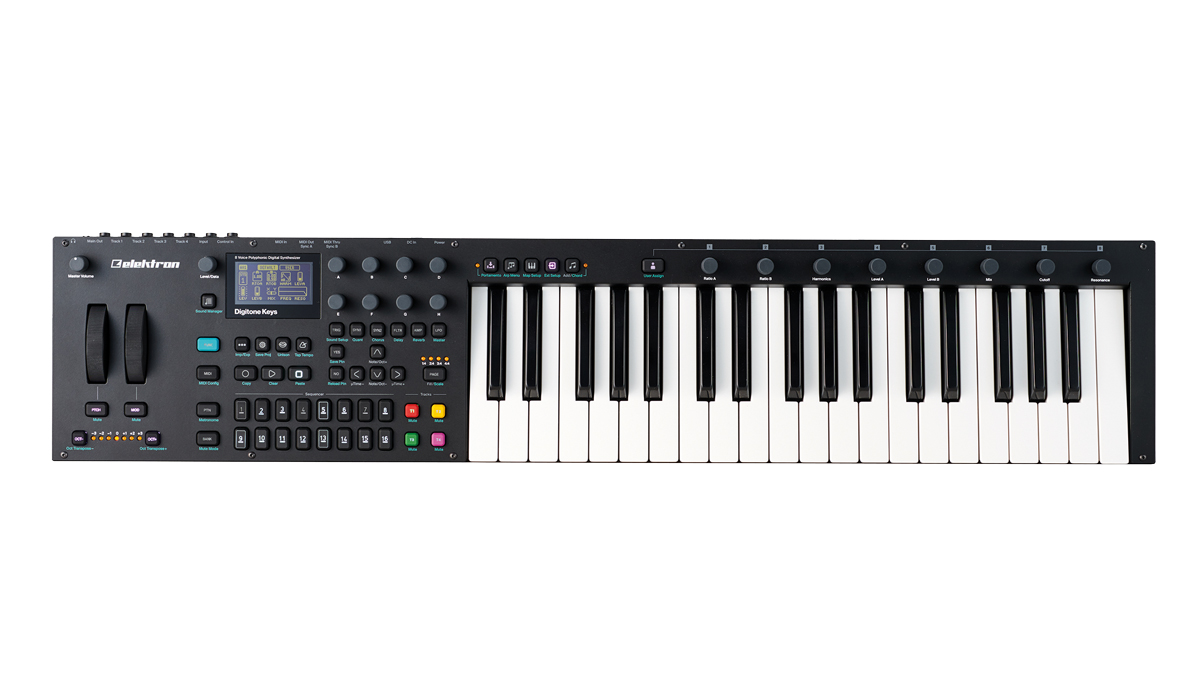MusicRadar Verdict
The Digitone just got better! Some may not like the look or price, but new performance controls and features really add appeal.
Pros
- +
Now a complete, self-contained instrument.
- +
Sounds classy and has a very versatile sound engine but now with lots more live/hands-on parameter control.
Cons
- -
The raised octave button placement under the wheels means they can be inadvertently hit.
- -
Looks a little tacked together given the extra cost.
MusicRadar's got your back
Last year we really enjoyed reviewing the standard Digitone and one of our suggestions to Elektron in that review was a knobby keyboard version.
Well hey presto - our wishes have seemingly been granted! For a more detailed in-depth feature/engine review, check out our original Digitone review as the sound engines are the same. However, the Digitone Keys has some rather nice additional functionality that will be the subject of this review - time to see what’s new then!

Firstly, the DK (as we shall hereby call it!) is ideal for using live and as a central studio hub, as it can now be a controller for external MIDI gear (when using its new keyboard, wheels and eight assignable encoders which run across the top of the keyboard). While it does look a little awkward (and like the Digitone has been tacked onto the end of a keyboard; which is essentially actually the case!) ergonomically, it works fine in practice except that without due care, you can hit the octave buttons by mistake when using the wheels. Regardless, the keybed feels very good quality with a nice amount of resistance (which enables more controlled playing), plus the aftertouch response feels great too.
The large pitch and mod wheels feel solid and high quality as expected, with a grippy rubber-type coating and these can be assigned as ‘macro’ controllers with each wheel controlling external MIDI gear or four user-defined internal sound parameters simultaneously, in varying amounts. These parameters are easily user-assigned by simply hitting the pitch or mod buttons below each respective wheel.
In addition, the new Sound Manager button takes you directly to the many excellent sounds onboard and using Map Setup you can now assign each of the four tracks/their sounds to different areas of the keyboard which comes in very handy if you want a bass in the bottom octave and a lead or pad in the top two octaves (for example). Having said this, a four-octave keybed would have been ideal here but then the unit would have been longer and likely needed a ground-up redesign.
The new Sound Manager button takes you directly to the many excellent sounds onboard
Further to this, the aforementioned assignable controls above the keyboard (which are preset to key parameters such as FM ratios and filter) are in a great place for instant live on-the-fly tweaking and grabbing and the DK now has stereo outs for each of the four sequencer tracks (which is great for running the sounds from each track into a mixing board for external processing). There’s also CV, expression and sustain pedal inputs plus a stereo audio input too, not forgetting standard MIDI DIN connections plus USB for MIDI and for outputting audio when you’re using Overbridge on your computer.
Couple all this with the classic Elektron 64-step (more than four pages) sequencer with parameter locks, the overall classiness of the sound, the excellent effects, arpeggiator per-part, new per-part hold button, great sounding unison mode and various portamento types, and the DK is really a welcome step up from the standard Digitone!
Want all the hottest music and gear news, reviews, deals, features and more, direct to your inbox? Sign up here.
